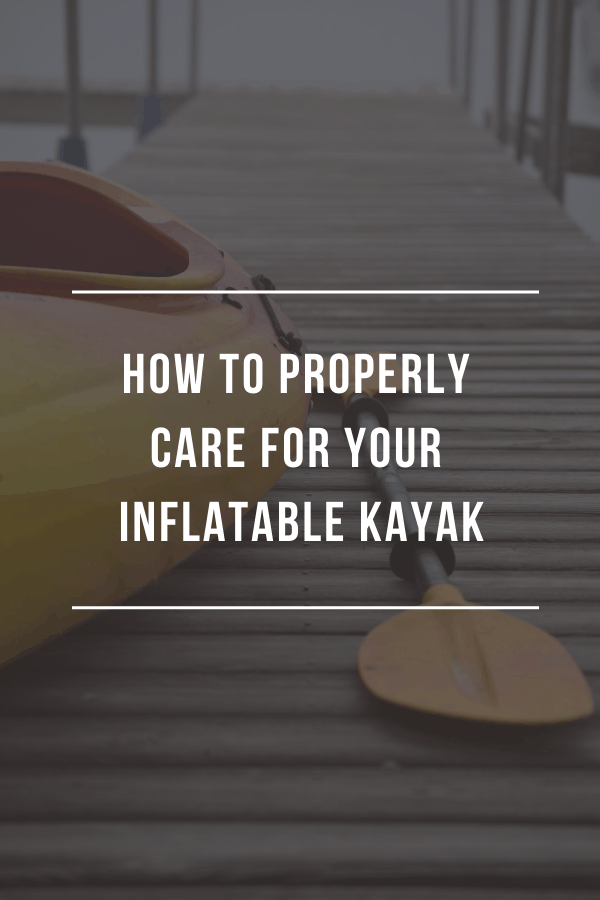Rugged, lightweight, and easy to store, the inflatable kayak makes ownership viable for paddlers who might not have the space to store a rigid kayak or the means to transport one.
The ability to be packed down to, in some cases, the size of a large duffle bag makes inflatable kayaks uniquely portable while advances in their construction materials and techniques have addressed many of the negative assumptions people make about their durability and utility for “real kayaking.”
Much like any kayak, your inflatable kayak will need to be cared for to keep it in pristine condition and for you to get the best out of it. Caring for an inflatable kayak is a little different from caring for a rigid kayak, so we’ve put together this simple and easy-to-follow guide to keeping your inflatable kayak in peak condition. Â Â
When You Are Inflating Your Kayak
Pumping up most inflatable kayaks is a simple and straightforward procedure, taking about three to five minutes to complete. However, if done incorrectly, you can damage your kayak’s valves or even the internal bulkheads, knows as “septums,” that separate the air chambers.
Keep these notes in mind while inflating your kayak.
- Clean the valves: Take a moment to clean any sand or dirt out of the valves, as foreign objects can block the valve during inflation and potentially cause it to rupture.
- Room to grow: Make sure to clear the area in which you plan to inflate your kayak of anything that might puncture the hull.
- Air pressure: If your kayak does not come with a pump then make sure to purchase one with a built-in air pressure gage. All inflatable kayaks will have a maximum air pressure to which they can be inflated and exceeding that pressure can damage your kayak, even tearing its internal septums. Once these septums are damaged, they are almost impossible to repair and will significantly affect the performance of your kayak.
- Get paddling: After your kayak is inflated, it’s best to get it out on the water as soon as possible. Leaving the kayak in direct sunlight or on hot asphalt or concrete will cause the air inside the kayak to expand, potentially rupturing the septums.
For more information on inflating your kayak, check out this video:Â
When You’re Done Using Your Kayak
The convenience of an inflatable kayak means there is often the temptation to quickly fold it up and pack it away after use. Unfortunately, this can lead to your inflatable kayak becoming damaged, particularly if you have been saltwater kayaking. Follow these steps after you’ve done your paddling:
- Remove any debris: Once you’ve finished using your kayak, it’s always a good idea to clean your kayak of any debris, including sand, dirt, algae, or anything transferred from you to the kayak, such as sunscreen. Grit, even in small amounts, can debraid the surface of your inflatable kayak, removing its UV protection and increasing the chances of it springing a leak.
- Rinse your kayak: After removing debris, you’ll want to rinse off any residue left by the water by rinsing off your kayak. Doing this will prevent a number of things that can shorten the life of your inflatable kayak. While you are cleaning your inflatable kayak, remember to close all the valves to prevent water from entering your kayak, as this can prompt the growth of mold and mildew inside the kayak. Rinsing your kayak off can prevent salt erosion if you have been sea kayaking. It can also prevent damage from any chemicals in the water that your kayak might have been exposed to. Rivers, in particular, can contain diesel, fuel oil, industrial and agricultural chemicals that will significantly shorten the life of your kayak if not washed off.
- Dry the kayak: Drying your kayak after use and cleaning will prevent the growth of mold and mildew on your kayak’s outer skin. In addition to being unsightly, mold and mildew can both degrade the skin of your kayak, thinning it and making it more susceptible to punctures.
For a better idea of how to clean your kayak, watch this video:Â
When Storing Your Kayak
Once your inflatable kayak has been rinsed, cleaned, and dried, you’ll need to fold and store it properly to prevent it getting damaged. While packing away an inflatable kayak is significantly easier than storing a full-sized rigid kayak, there are a few tricks you can use to make sure your kayak stays in peak condition, even when stored.
- Do not store your kayak inflated: Keeping your kayak inflated over long periods of time can damage the valves and place extra strain on the kayak’s skin. Changes in temperature can also cause the air in your kayak to expand, potentially rupturing one of its internal septums.
- Rolling/Folding the kayak: Roll your kayak up in a slightly different fashion each time you store it. Rolling or folding your kayak up the same way each time you put it away results in seams being formed in the kayak’s skin. Over time, these seams can form weak points on the kayaks hull where you are more likely to end up with a puncture.
- Storing your kayak: Store it in a cool, dry place to prevent mold or mildew growth. If you are storing your kayak outside, or in a shed or outhouse, make sure to shield it with a tarpaulin or similar cover to prevent debris accidentally falling on it. If there is any chance of animal activity near your kayaks, such as rats or mice, store it in a sealable container to prevent them from damaging it.
Check out this video for tips on how to deflate, roll, and store your kayak:Â
Staying Pumped
Inflatable kayaks are an easy option to keep and store a kayak if you don’t have the space to accommodate a full-sized rigid boat.
They can be easily packed down and stored away without needing large amounts of space and you don’t have to worry about the logistics of transporting your kayak to the water since it’s small enough to fit in the back of your car.
Inflatable kayaks are also extremely practical when it comes to kayaking with minimum preparation. Quick and easy to inflate, they let you get out on the water whenever you feel the need.
However, like all kayaks, inflatable kayaks do need some aftercare to keep them in peak condition. If you follow our simple guide and clean, dry, and store your kayak properly, you can enjoy its convenience without worrying about springing a leak.


